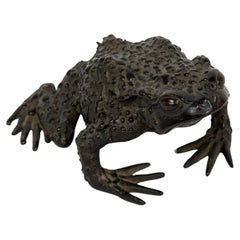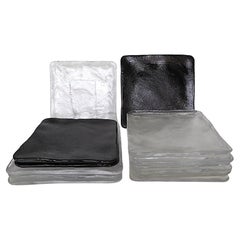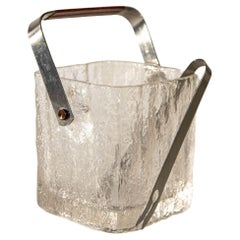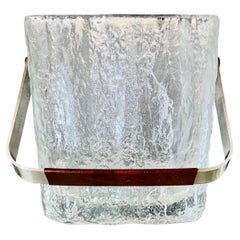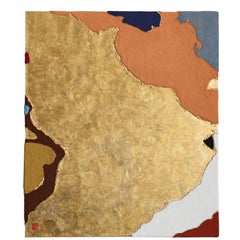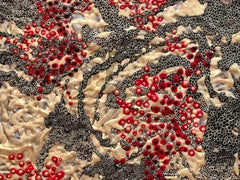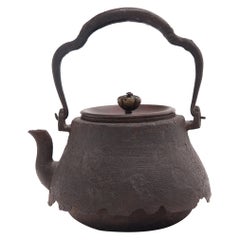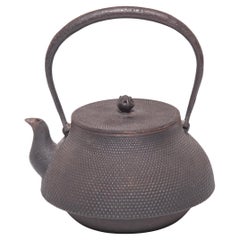Japanese Textural Art
to
12
1
11
5
4
4
3
3
2
2
1
2
1
1
1
Sort By
Japanese bronze okimono or sculpture of a textured toad
Located in PARIS, FR
wealth. Kaeru means both “toad” or “frog” and “to return home” in Japanese. This meaning is due to the
Category
Early 20th Century Japanese Meiji Metalwork
Materials
Bronze
Vintage 14 Sugahara Handcrafted SUKIYA Textured Square Glass Dishes Japan 1970s
Located in Miami, FL
Set of 14 SUKIYA pattern (#240) Organic Modern square textured solid glass dishes Made in Japan in
Category
Vintage 1970s Japanese Organic Modern Dinner Plates
Materials
Art Glass
H 0.63 in W 9.4 in D 9.4 in
Vintage Hoya Glacier Ice Bucket With Textured Ice Glass, Japan, Circa 1960s
Located in North Hollywood, CA
Vintage Mid-Century Modern Hoya Glacier Ice Bucket With Textured Ice Glass, Japan, Circa 1960s
Category
Mid-20th Century Japanese Mid-Century Modern Barware
Materials
Art Glass
H 5 in W 4.75 in D 5.5 in
Mid-Century Modern Ice Bucket with Textured Ice Glass, Japan, circa 1960s
Located in Fort Lauderdale, FL
Mid-Century Modern Japanese personal size ice bucket comprised of thick chunky glass with polished
Category
Vintage 1960s Japanese Mid-Century Modern Barware
Materials
Stainless Steel
H 5.25 in W 4.75 in D 4.75 in
Furaha Mbili - Japanese Gold Leaf and Minerals, 3D Textured Abstract Painting
By Maria Mitsumori
Located in Tokyo, JP
This original abstract painting is a 2 piece set, sold individually. Both are highly textured
Category
2010s Contemporary Abstract Paintings
Materials
Stone, Gold Leaf
H 20.87 in W 17.72 in D 1.19 in
Furaha Moja - Japanese Gold Leaf and Minerals, 3D Textured Abstract Painting
By Maria Mitsumori
Located in Tokyo, JP
This original abstract painting is a 2 piece set, sold individually. Both are highly textured
Category
2010s Contemporary Abstract Paintings
Materials
Stone, Gold Leaf
H 20.87 in W 17.72 in D 1.19 in
"Japan" textures swirl in opalescent, glossy and matte white, red and black
By Elizabeth Knowles
Located in New York, NY
". Full sized view is shown in secondary images.
"Japan" opalescent patterns swirl glossy and matte
Category
21st Century and Contemporary Abstract Abstract Paintings
Materials
Canvas, Acrylic
Japanese Tetsubin with Woven Texture, c. 1900
Located in Chicago, IL
Decorated with an irregular, textured surface, this Japanese teapot was used to boil water for
Category
Early 20th Century Japanese Meiji Metalwork
Materials
Bronze, Iron
Textured Japanese Tetsubin Teapot with Lotus Bud Knob, c. 1900
Located in Chicago, IL
Decorated with a dotted, textured surface and an elegant arched handle, this Japanese teapot was
Category
Early 20th Century Japanese Meiji Metalwork
Materials
Bronze, Iron
Tatsuzo Shimaoka Fishnet Textured Japanese Flask
By Tatsuzo Shimaoka 2
Located in Sharon, CT
Beautiful flask in the tradition of Hamada, but with the original embossed textured fish net
Category
Vintage 1970s Japanese Anglo-Japanese Ceramics
Materials
Ceramic
Early 20th Century Textured Japanese Tetsubin
Located in Chicago, IL
Decorated with an irregular, textured surface and an elegant, arched handle, this Japanese teapot
Category
Early 20th Century Japanese Meiji Metalwork
Materials
Bronze, Iron
Mid-Century Modern Ice Bucket with Textured Ice Glass, Japan, circa 1960s
Located in Fort Lauderdale, FL
Mid-Century Modern glass ice bucket with textured ice cube design. Vintage Japanese personal size
Category
Vintage 1960s Japanese Mid-Century Modern Barware
Materials
Stainless Steel
H 5.25 in W 4.75 in D 4.75 in
Mid-Century Modern Ice Bucket with Textured Ice Glass, Japan, circa 1960s
Located in Fort Lauderdale, FL
Mid-Century Modern glass ice bucket with textured ice cube design. Vintage Japanese personal size
Category
Vintage 1960s Japanese Mid-Century Modern Barware
Materials
Stainless Steel
H 5.25 in W 4.75 in D 4.75 in
Contemporary Ceramic Textured Bottle Vase by Harada Shuroku
By Harada Shuroku
Located in Los Angeles, CA
Offered by J R Richards
A textured bottle shaped vase by internationally known ceramic artist
Category
2010s Japanese Ceramics
Materials
Ceramic
Long Golden Textured Woven Obi Textile Depicting Flowers in Bloom
Located in Oakland Park, FL
Golden textured woven Obi textile depicting flowers in bloom,
in shades of deep purple, gold
Category
Vintage 1940s Japanese Japonisme Textiles
Materials
Metallic Thread
Get Updated with New Arrivals
Save "Japanese Textural Art", and we’ll notify you when there are new listings in this category.
Japanese Textural Art For Sale on 1stDibs
You are likely to find exactly the piece of japanese textural art you’re looking for on 1stDibs, as there is a broad range for sale. In our selection of items, you can find contemporary examples as well as an abstract version. Making the right choice when shopping for an item from our selection of japanese textural art may mean carefully reviewing examples of this item dating from different eras — you can find an early iteration of this piece from the 18th Century and a newer version made as recently as the 21st Century. If you’re looking to add a choice in our collection of japanese textural art to create new energy in an otherwise neutral space in your home, you can find a work on 1stDibs that features elements of gray, beige, black, blue and more. Creating an object in our assortment of japanese textural art has been a part of the legacy of many artists, but those crafted by Ekaterina Ermilkina, Hiro Yokose, Martha Mans, Chase Langford and Takashi Murakami are consistently popular. Artworks like these of any era or style can make for thoughtful decor in any space, but a selection from our variety of those made in paint, fabric and canvas can add an especially memorable touch.
How Much is a Japanese Textural Art?
The price for an artwork of this kind can differ depending upon size, time period and other attributes — a piece of japanese textural art in our inventory may begin at $49 and can go as high as $1,750,000, while the average can fetch as much as $2,488.
Questions About Japanese Textural Art
- 1stDibs ExpertApril 5, 2022The writing on Japanese art is calligraphy art called shodo. It uses Japanese kanji and kana characters. There are a variety of different shodo styles of art, including Kaisho, which is the basic, foundational form of the art. On 1stDibs, find a range of Japanese calligraphy art from top sellers..
- 1stDibs ExpertApril 16, 2024The focus of Japanese art varies. Many traditional Japanese artists sought to capture the beauty of nature in their works. However, other Japanese artists have produced work with Buddhist themes, and contemporary artists working in the country have been inspired by a range of subjects, from socioeconomic and political issues to pop culture. On 1stDibs, explore a large selection of Japanese art.
- 1stDibs ExpertApril 5, 2022There are a variety of different types of Japanese art. One of the oldest and most admired forms of Japanese art is the art of calligraphy, which originated in the sixth or seventh century. Another type of art, ukiyo-e, is the art of the woodblock print, which depicts scenes of female beauties; kabuki actors, sumo wrestlers and more. You’ll find a variety of Japanese artwork from some of the world’s top art dealers on 1stDibs.
- 1stDibs ExpertApril 5, 2022Many art styles originated in Japan and grew in popularity over the years. Some of the most popular styles include shodo (calligraphy), ikebana, kanou and yamato-e. You’ll find a wide variety of authentic Japanese art from some of the world’s top dealers on 1stDibs.
- 1stDibs ExpertApril 5, 2022What Japanese wall art is called depends on its type. There are numerous kinds of Japanese paintings and prints, including nihonga and ukiyo-e. A Japanese wall scroll is known as a kakejiku or kakemono. On 1stDibs, find a variety of Japanese wall art.
- 1stDibs ExpertSeptember 23, 2024What the Japanese sea art is called depends on its type. Many examples of sea art from Japan are called ukiyo-e. This term refers to woodblock prints made during the 17th, 18th and 19th centuries. The Great Wave off Kanagawa by Katsushika Hokusai is arguably the most famous ukiyo-e print depicting the sea. On 1stDibs, find a wide variety of Japanese woodblock prints.
- 1stDibs ExpertOctober 15, 2024To tell if art is Japanese or Chinese, study the piece's characteristics. With paintings, Chinese artists often use more color and tend to fill their entire canvases, while Japanese artists often include more negative space and choose subtler colors. There are also differences between the brushstrokes typical of traditional Chinese and Japanese art. In Japanese paintings, brushstrokes are often short and sharp. On the other hand, Chinese paintings often display longer, more fluid brushstrokes. Learning about the defining features of various art forms and periods and looking at examples of pieces made by Japanese and Chinese artists can help you learn to spot subtle differences. Explore a diverse assortment of Japanese and Chinese art on 1stDibs.
